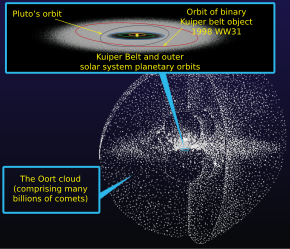Tyche (hypothetical planet)

Tyche
History
Matese, Whitmire and their colleague Patrick Whitman first proposed the existence of this planet in 1999,[9] based on observations of the orbits of long-period comets. Most astronomers agree that long-period comets (those with orbits of thousands to millions of years) have a roughly isotropic distribution; that is, they arrive at random from every point in the sky.[10] Because comets are volatile and dissipate over time, astronomers suspect that they must be held in a spherical cloud tens of thousands of AU distant (known as the Oort cloud) for most of their existence.[10] However, Matese and Whitmire claimed that rather than arriving from random points across the sky as is commonly thought, comet orbits were in fact clustered in a band inclined to the orbital plane of the planets. Such clustering could be explained if they were disturbed by an unseen object at least as large as Jupiter, possibly a brown dwarf, located in the outer part of the Oort cloud.[11][12] They also suggested that such an object might explain the trans-Neptunian object Sedna's peculiar orbit.[13] However, the sample size of Oort comets was small and the results were inconclusive.[14]
Orbit
Whitmire and Matese speculated that Tyche's orbit would lie at approximately 500 times
Mass
In 2011, Whitmire and Matese speculated that the hypothesized planet could be up to four times the mass of
Origin of name
WISE mission
The Wide-field Infrared Survey Explorer (WISE) space telescope has completed an all-sky infrared survey that includes areas where Whitmire and Matese anticipate that Tyche may be found.[7] On March 14, 2012, the first-pass all-sky survey catalog of the WISE mission was released.[21] The co-added (AllWISE) post-cryo second survey of the sky was released at the end of 2013.[22] On March 7, 2014, NASA reported that the WISE telescope had ruled out the possibility of a Saturn-sized object out to 10,000 AU, and a Jupiter-sized or larger object out to 26,000 AU (0.4 light-years).[6][23]
See also
- Kelvin–Helmholtz heating
- Nemesis (hypothetical star)
- Planet Nine
- Planets beyond Neptune
- Vulcan (hypothetical planet)
Notes
- billion years of cooling, large gas giants are all very nearly Jupiter's radius, but more massive objects are slightly smaller.[18]
References
- ^ Rodgers, Paul (February 13, 2011). "Up telescope! Search begins for giant new planet". The Independent. Retrieved February 14, 2011.
- ^ Wolchover, Natalie (February 15, 2011). "Article: Astronomers Doubt Giant Planet 'Tyche' Exists in Our Solar System". Space.com. Retrieved February 15, 2011.
- ^ "Astrophysics Homepage of John J. Matese". Ucs.louisiana.edu. September 21, 2011. Retrieved April 1, 2013.
- ^ "Daniel P. Whitmire". Ucs.louisiana.edu. Retrieved April 1, 2013.
- ^ Whitney Clavin (February 18, 2011). "Can WISE Find the Hypothetical 'Tyche'?". NASA/JPL. Retrieved February 19, 2011.
- ^ a b Clavin, Whitney; Harrington, J.D. (March 7, 2014). "NASA's WISE Survey Finds Thousands of New Stars, But No 'Planet X'". NASA. Retrieved March 7, 2014.
- ^ S2CID 44204219.
- ^ Helhoski, Anna. "News 02/16/11 Does the Solar System Have Giant New Planet?". The Norwalk Daily Voice. Retrieved July 10, 2012.
- Bibcode:2002ESASP.500..309M. Retrieved March 21, 2008.
- ^ a b
Harold F. Levison; Luke Donnes (2007). "Comet Populations and Cometary Dynamics". In Lucy Ann Adams McFadden; Lucy-Ann Adams; Paul Robert Weissman; Torrence V. Johnson (eds.). Encyclopedia of the Solar System (2nd ed.). Amsterdam; Boston: ISBN 978-0-12-088589-3.
- .
- Seth Borenstein (October 11, 1999). "A 10th planet may be out there: Or new object could be the sun's long-lost twin, astronomers say". Houston Chronicle. Archived from the original on 1999-11-28.
- .
- S2CID 13647204.
- ^ Plait, Phil (February 14, 2011). "No, there's no proof of a giant planet in the outer Solar System". Discovery Magazine. Archived from the original on April 16, 2016. Retrieved February 15, 2011.
- ^ "Orbital period of a planet at a distance of 15000 AU with a circular orbit". Retrieved February 15, 2011.
- ^ "Have UL Physicists Identified a New Planet?". University of Louisiana. February 14, 2011. Archived from the original on August 1, 2015. Retrieved February 16, 2011.
- ^ more massive than Earth.
- S2CID 118513110.
- ^ Bruce Dorminey (March 31, 2013). "Sun May Still Have Low-Mass Solar Companion, Say Astrophysicists Searching NASA WISE Mission Data". Forbes. Retrieved April 1, 2013.
- ArsTechnica. Retrieved March 21, 2011.
- ^ "NASA Releases New WISE Mission Catalog of Entire Infrared Sky". NASA/JPL. March 14, 2012. Archived from the original on June 4, 2012. Retrieved March 15, 2012.
- ^ Wide-field Infrared Survey Explorer
- S2CID 122930471.

